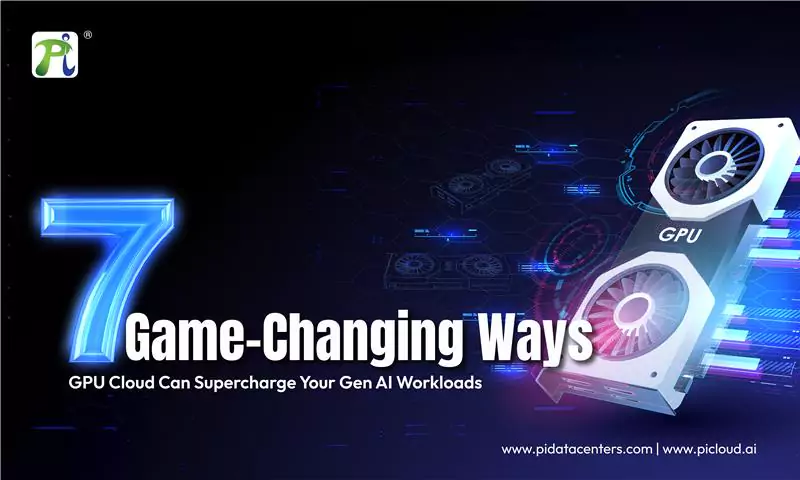
Game-Changing Ways GPU Cloud Can Supercharge Your Gen AI Workloads
As generative AI (Gen AI) transforms industries by creating intelligent content, personalizing interactions, and automating tasks, the demand for high-performance GPU infrastructure has increased. The 2025 State of AI Infrastructure Report says that 90% of IT leaders are already using Gen AI. However, 44% say that infrastructure problems are a big reason why they can't grow. The Uptime Institute that 32% of data center operators are already using AI inference workloads, and 45% plan to do so soon.
Although this represents evident progress, traditional public cloud environments often fail to meet the needs of large AI/ML workloads due to limitations in performance, cost, and the need for enterprise-level control.
Pi Datacenters' GPU Cloud is a powerful alternative designed to meet the specific needs of Gen AI in 2025. Pi gives businesses the tools they need to build, train, and deploy AI models faster, smarter, and more efficiently. These tools include cutting-edge NVIDIA A100 and H100 GPUs, low-latency networking, and secure Tier 4 colocation environments.
-
1. Dedicated GPU Power for Unmatched Performance (NVIDIA A100/H100):
Dedicated access to NVIDIA A100 and H100 GPUs gives full access to high-performance computing resources. This eliminates the performance fluctuations caused by shared infrastructure, a common issue in public clouds. For data scientists and AI engineers, this translates to faster model training and more predictable outcomes. For the business, it means accelerated time-to-market, better resource utilization, and reduced overhead from job failures or delays. With the H100 offering transformer engine acceleration, training large language models (LLMs) or generative models becomes significantly more efficient.
- A100: Ideal for training large language models (LLMs), computer vision, and recommendation systems. It supports multi-instance GPU (MIG) for partitioned resource use.
- H100: Built on NVIDIA Hopper architecture, it offers up to 6x speed improvements for transformer-based models, making it ideal for next-generation generative AI applications, such as text-to-image or multimodal systems.
- 2. Ultra-Low Latency for Real-Time AI Tasks: Real-time AI systems demand instant processing to deliver seamless user experiences. Whether it's a chatbot responding in milliseconds or an image generator reacting to live prompts, latency can make or break your product. Pi's strategically located Tier 4 data centers drastically cut response time. This ensures that AI workloads, such as fraud detection, autonomous interactions, or Gen AI customer service apps, operate with near-instant response rates, thereby enhancing end-user satisfaction and system reliability.
- 3. Cost-Effective GPU-as-a-Service Model: Infrastructure costs are a significant concern for enterprises scaling Gen AI. Pi offers a transparent and predictable GPU-as-a-service model, meaning no surprise charges (e.g., data egress fees or idle GPU billing). Flexible options, such as hourly pricing or reserved capacity, allow businesses to align their spending with actual usage. This model enables more accurate budget forecasting for CIOs while maximizing the ROI of every GPU hour utilized. With A100 for training and H100 for large-scale inference or multitasking, businesses get top-tier performance without CapEx burdens.
-
4. Enterprise-Grade Security and Compliance:
In industries like healthcare, BFSI, and government, running AI models securely is non-negotiable. Pi's infrastructure is equipped with:
- 24x7 biometric access
- CCTV surveillance
- DDoS protection
- Data localization compliance, ensuring sensitive data stays within national borders (e.g., India)

-
5. Seamless Scalability for Growing AI Teams:
As your AI projects scale—encompassing more users, models, and data—your infrastructure must scale accordingly. Pi's GPU Cloud offers:
- Quick provision of new GPU resources on-demand
- Support for NVIDIA's MIG, allowing one GPU to be divided across multiple teams or tasks
- Elastic infrastructure so organizations don't have to re-architect systems as they grow
-
6. Full Remote Hands and 24/7 AI Support:
High-end GPU workloads require expert-level support. Pi offers real-time remote hands services that extend your IT team's capabilities:
- Immediate action for physical tasks (reboot, hardware checks)
- Help with driver updates, GPU utilization monitoring, and system tuning
- 24/7 support ensures that your Gen AI infrastructure is never a bottleneck
-
7. Hybrid-Cloud Ready for Maximum Flexibility:
Modern AI architecture is rarely monolithic. Teams utilize a combination of public clouds, on-premises systems, and edge deployments. Pi supports this with:
- Hybrid cloud connectivity enables you to shift workloads between environments seamlessly
- Compatibility with tools like Kubernetes, Kubeflow, and ML Flow for easy orchestration
- You can run model training on Pi's H100-powered cloud and serve inference on-prem or in another cloud—based on cost, performance, or data governance needs
Why These Benefits Matter
Together, these benefits create a robust, production-grade GPU infrastructure that is:
- Technically advanced for AI/ML teams
- Financially optimized for business stakeholders
- Secure and compliant for regulated industries
- Flexible and scalable for future growth